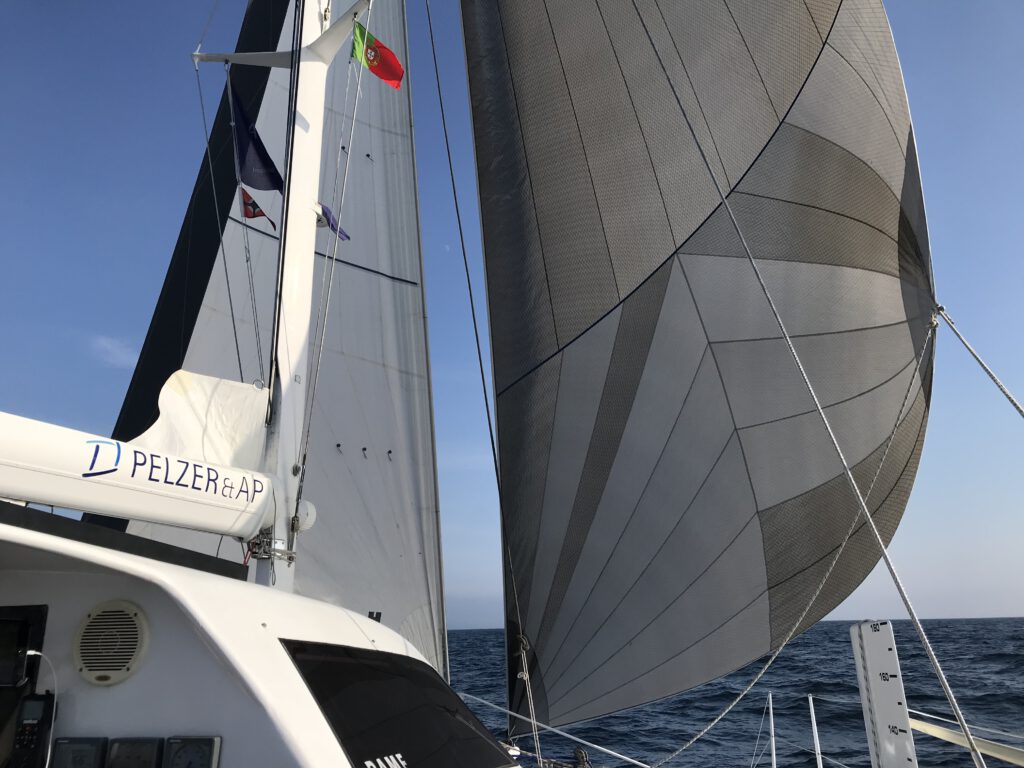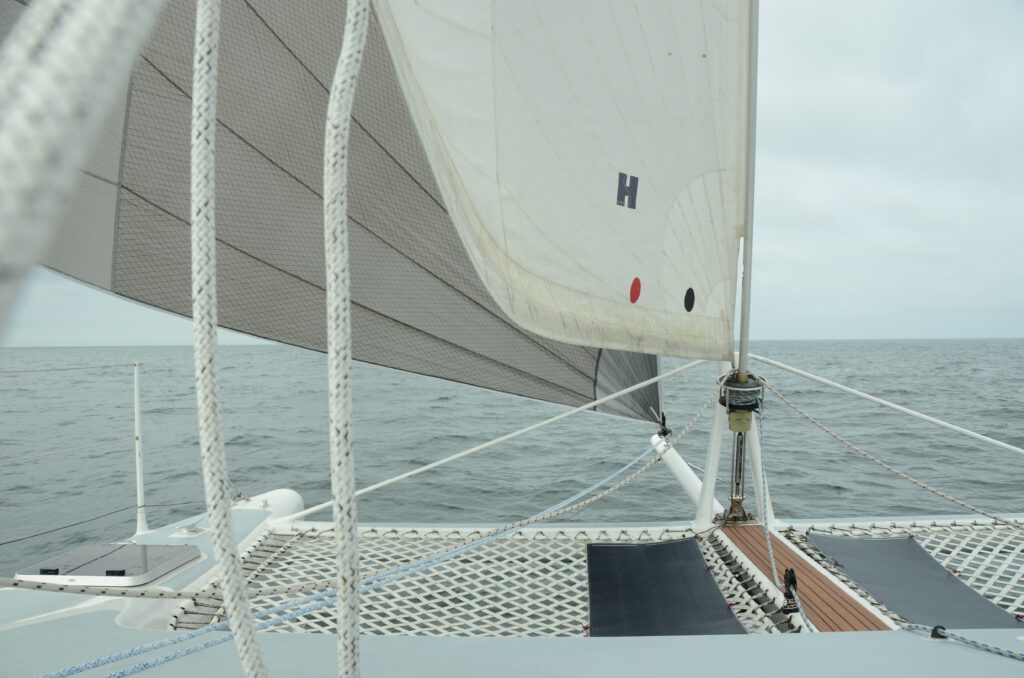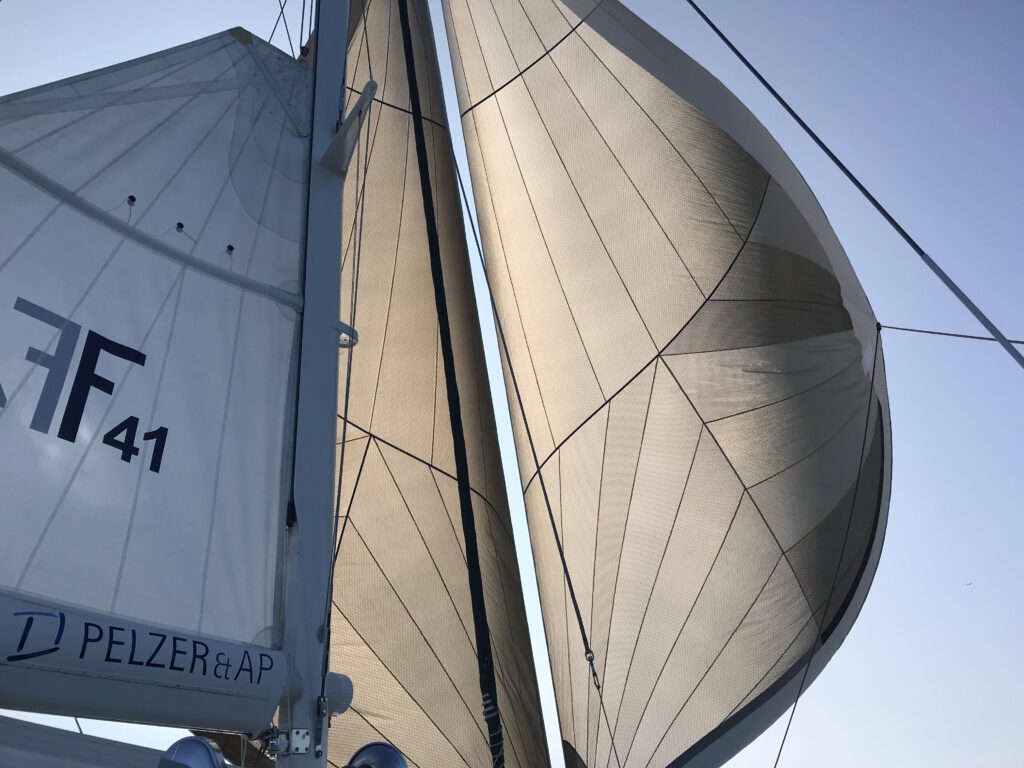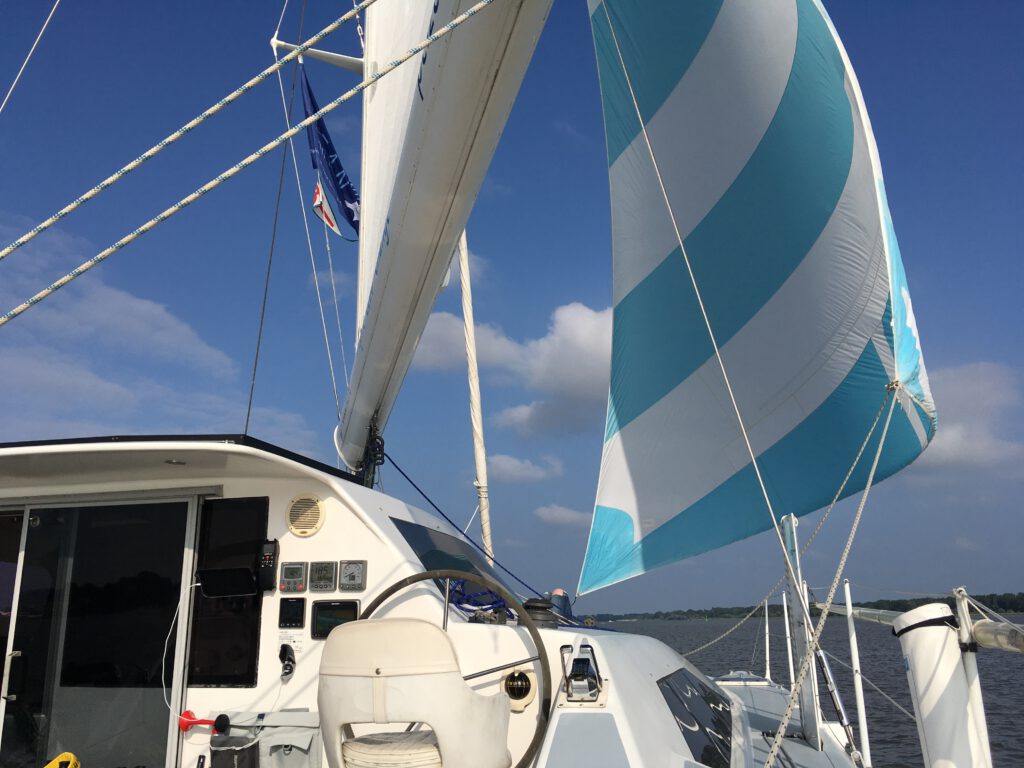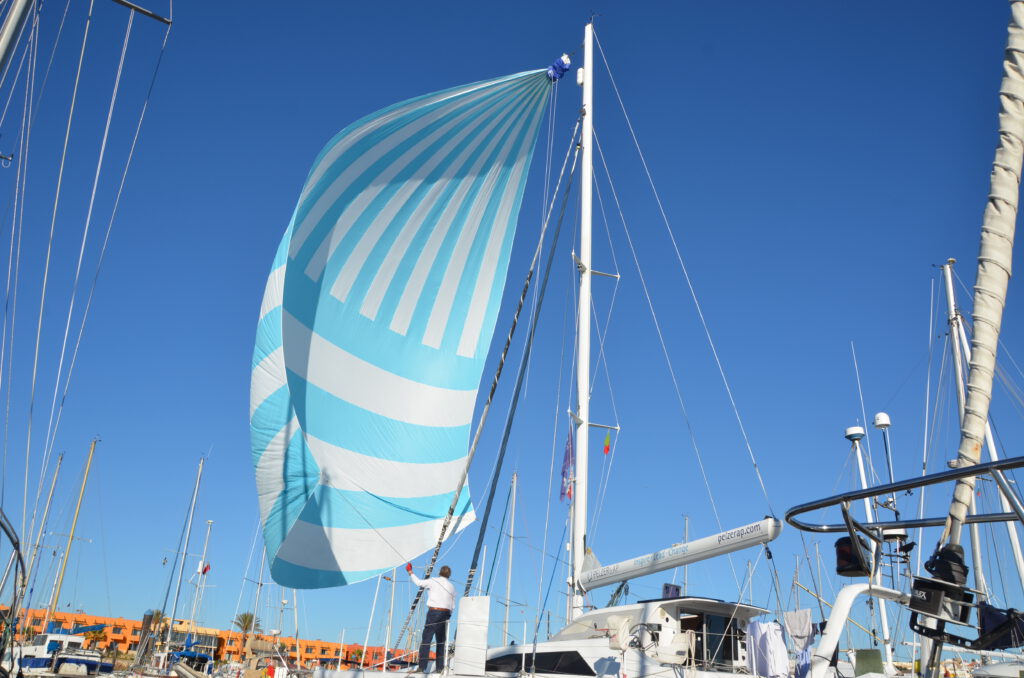Under Sails
How to find the balance between performance, handling and cost?
After some intermediate steps and experiences with other yachts and boats, we have found a balance between these three poles on our F41 catamaran.
Effective are traditional sails such as gaff sails, which come close to an elliptical shape and can thus use the wind effectively. The performance of traditional triangular sails is limited. These were created by the competitive passion of the British, who developed balancing formulas for different ships during sailing races on the Thames.
(Sciarelli: „Lo yacht. Origine ed evoluzione del veliero da diporto“ (1970) https://www.amazon.de, Italian)
(Sciarelli: „Die Yacht. Ihre Herkunft und ihre Entwicklung“ (1973) https://www.amazon.de, German)
One of these formulas penalised the size of the gaff, which led to the current shape of triangular mainsails. Also, unlike gaff sails, triangular tall rigs are easier to operate by a smaller crew, but require stronger materials.
In modern rigs that are not constrained by racing measurement formulas, the gaff comes back in the form of the effective square sail – Well seen in the Americas Cup yachts, the Volvo Ocean Race (VO65 and Imoca 60) or the A Cat class.
Touring catamarans also have a corresponding sail batten in the top. Our mainsail is furled on a Leisure-Furl boom, which we have kept for comfort and cost reasons, even though this furling sail costs about 25% power – compared to a fully battened squaretop sail. In the meantime, we really like the stepless reefing option at the push of a button and have taken to reefing a little later than we would have to with a high-performance squaretop sail. This saves nerves and power. The only restriction is the amount of height on the wind that we can run with this sail. A high-end sail would probably go 5 ° higher. This is also due to the fact that the battens in a groove-guided sail can only exert half the horizontal pressure as a batten sitting in a furling car. So trimming the mainsail flat has its limitations.
The height on the wind is lower with a cat compared to slender monohulls. Therefore, investing in sails that promote height on the wind makes little sense. For example, 3D sails, which hold the profile shape chosen by the designer beautifully, are therefore superfluous for catamarans.
In the last three years, we have only once used our cat to the full height on the wind that our F41 can sail with its two daggerboards: We sailed upwind for two days on the English south coast at NW high on the wind. With reefed main and working jib, we still had 13 knots of speed in 22 knots of wind. However, this meant that every third wave rolled over into the cockpit and the spray from the port bow blew as a flag 15 metres astern. Arriving in Falmouth completely exhausted and soaked with salt water, we decided not to use this uncomfortable performance option of our boat in the future.
A flat sail trim on board a cat has different limitations than on monohulls. The large beam and design limitations do not allow for the rig tensions that are possible on monohulls. We have experienced older series catamarans that were so soft that we could screw the shroud tensioners completely loose without the wires coming loose, because the hulls simply sank down with them. If you then tighten the shrouds as much as you are used to on monohulls, the doors on these catamarans jam!
In catamaran rig designs, the mast profile is defined by the diamond stays. The mast is held only by the forestay and the windward shroud. The leeward shroud hangs loose. Some even tension it aft with long rubber bands to keep it from dangling. On our F31 trimaran, the windward shroud could be tensioned aft at a joint with an 8-fold shorn tackle, which trimmed the mast up to 12 degrees to windward. At 15 degrees heel, the mast was almost upright. This gave power – also because the aft tension in the rig meant that the two headsails (jib and code 0 on the jib boom) could be put through better.
Rigg: Sloop Squaretop
Standing rigging: Turning Carbon mast 16,50m
Stainless steel shrouds and forestay 14mm
Main sail: 62 m² fully battended with Squaretop, Grant Piggot (2018)
Dacron, reefable on Leisure-Furl furling boom,
with cover made by Clownsails (2020)
Fock: 25m² Hyde (2009)
reefable on Pro-Furl roller unit, with sun protection edge
Genua 3: 35m² Clownsails (2022)
reefable on Pro-Furl roller unit, with sun protection edge
Code 1: 65 m² Clownsails (2020)
Carbon offshore, double layer with sun protection edge
on Seldén CX 25 roller system
Code 0: 75 m² Clownsails (2018)
Carbon light wind with sun protection edge
on Seldén CX 15 roller system
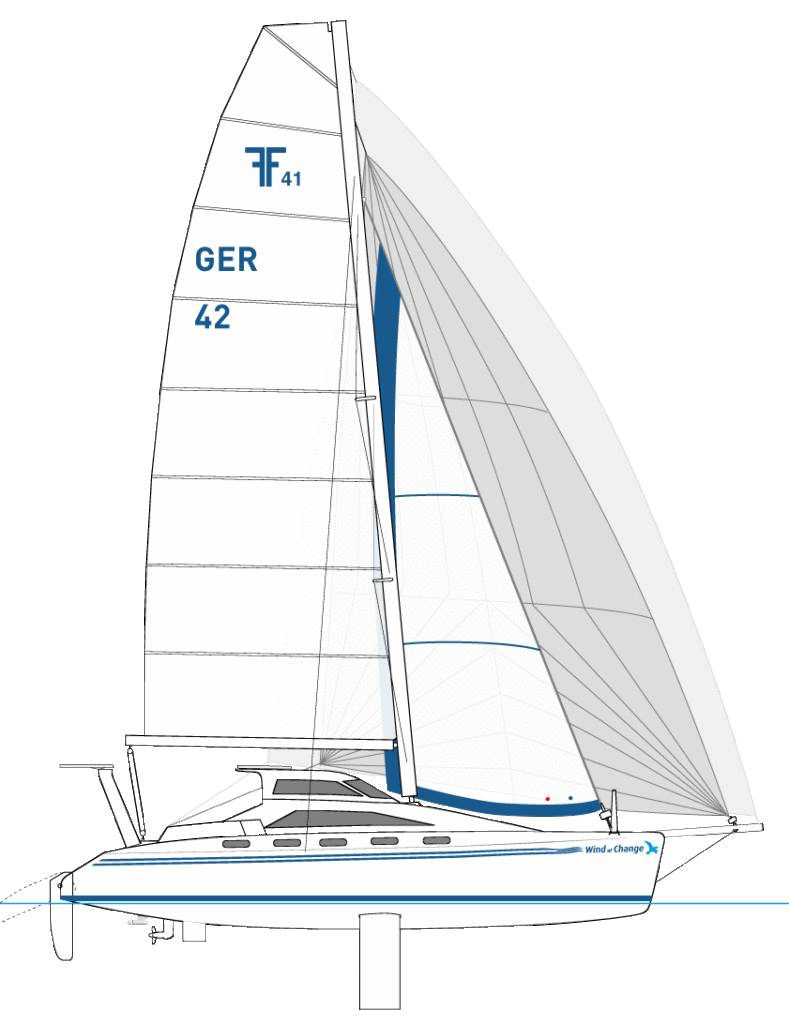
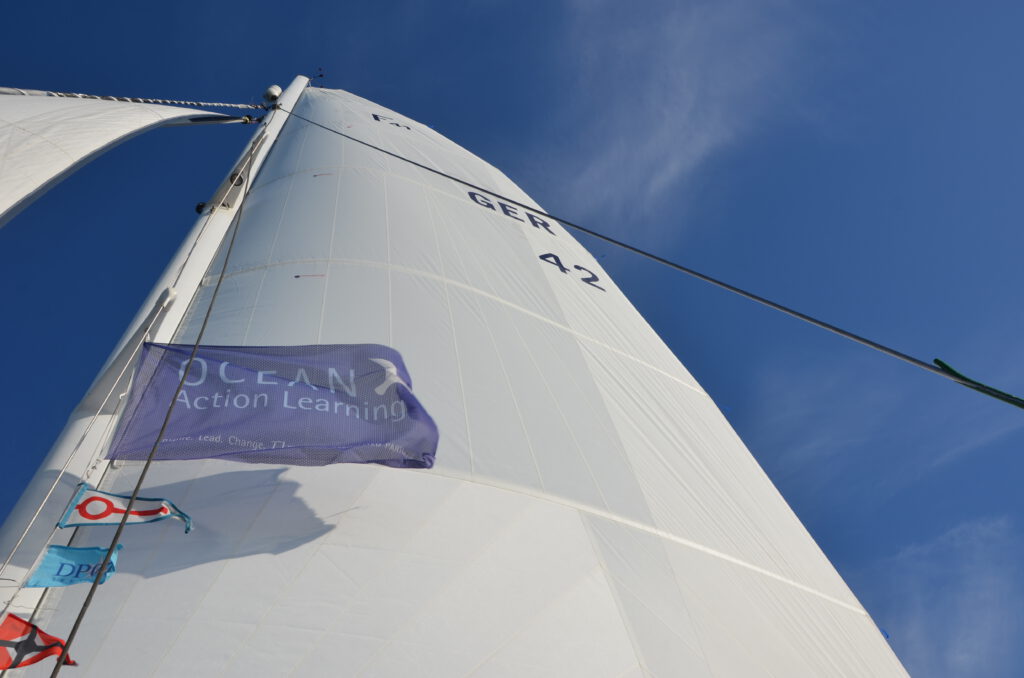
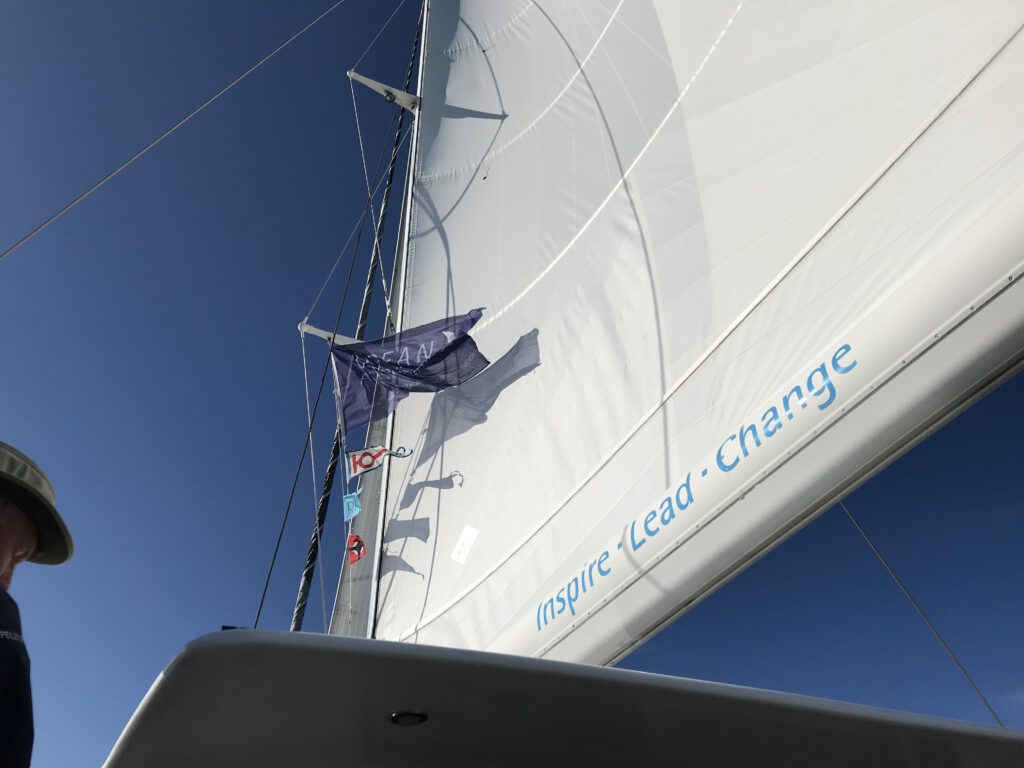
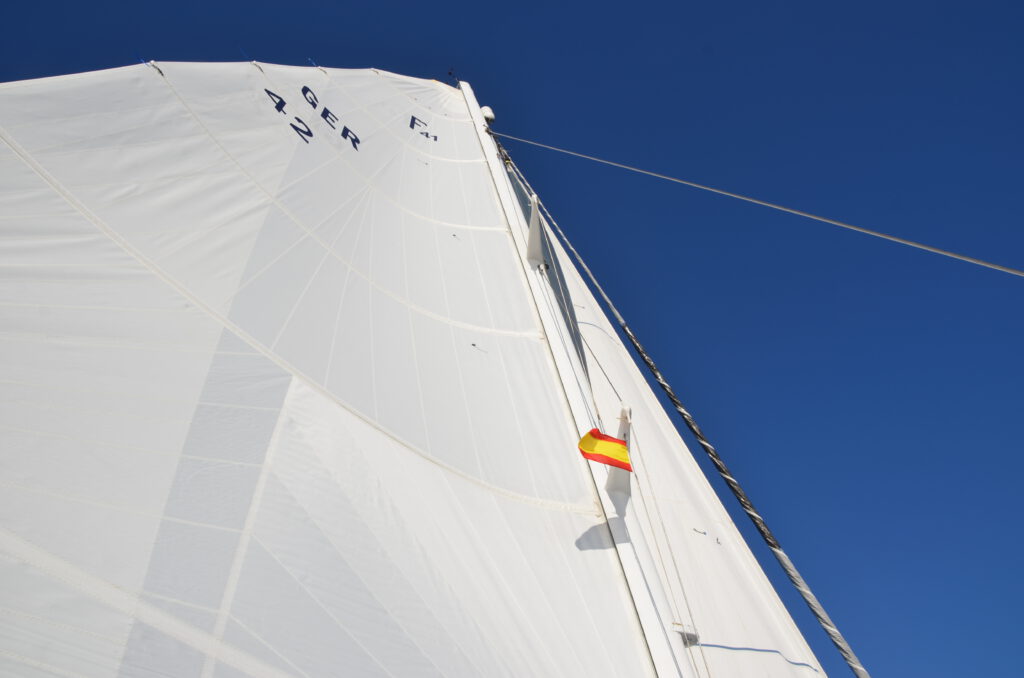
Headsail performance is crucial on a cat.
Not only because sailing upwind is very uncomfortable especially on a catamaran, but because the speeds achieved with it give us corresponding safety. Headsails relieve the pressure on the foreship. They pull us slightly up out of the water, so to speak, while the mainsail keeps pushing us deep into the water in front. We planned and sailed days of passages in such a way that we averaged over 8 knots with our Code 1 as the only sail. To use our headsail power in any wind, we extended to three of them, which are permanently in use (Code 0, Code 1 and jib).
We learned this from the Volvo Ocean Racers (VO65). In a construction class where all boats are standardised, no one cares about calculation formulas and the resulting performance restrictions.
Therefore, it makes sense to take a close look at these boats: What caught my eye were fully battened profiled squaretop mainsails and the possibility of running three headsails at the same time. In addition, the spinnaker is missing from the sail wardrobe carried! So we cross downwind because it’s just faster. It reminded me of the fun we had with our F31 trimaran. Imagine a beautiful Sunday on the Elbe with sun, 8 kn north-east wind. Maybe 3 kn of outgoing water. Then all the lead boats (monohull yachts) go out in Wedel and there is a beautiful picture of colourful spis all over the horizon. After everyone was out, we crossed the Elbe to Hanskalbsand without a spinnaker to sail back on the Elbe higher up the wind.
Then it starts: 5 kn wind with 4 kn speed. At 10 kn apparent wind the starboard float lifts out of the water and at 12 kn speed at 20 kn apparent wind the centre hull lifts. At 16 kn speed we are sailing with flying hull and tightly banged sails high on the apparent wind and catching up with the regatta field.
We overtake one yacht after the other and most of them don’t understand that we are sailing in the same wind – just differently. It’s all about the resistance in the water and the apparent wind: Ice sailors can do over 40 knots of speed in 10 knots of wind! Modern, foiling ships (such as Boris Hermann’s Seaexplorer) usually sail in aft winds with tightly banged headsails high in the apparent wind.
Slender cut sails, called Code 0-3, are important for this. We sail a Code Zero of 75 sqm made of light carbon right at the front on the 2.40 m jib boom. 50 cm further aft is the Code One, a 65 sqm double laminated foil sail with a carbon layer. At the bow comes the 35 sqm, continuously reefable furling jib made of double laminated fabric and dark blue sun protection edge. The two high-tech headsails were built by Frank Schönfeld / Julius Raithel from Clownsails in Hamburg. Our new fully battened mainsail made of Dacron with a 60 cm squaretop batten brings 62 sqm into the wind and was built by sailmaker Grant Piggot in England / Hamble River, who also excellently reinforced the existing jib with a sunshade and aluminium clew, thus also improving its performance.
Underway on long voyages:
On long trips we try to maintain a minimum speed of 5 kn for an etmal (distance travelled in 24 hrs) of at least 120 nm. This is possible with 240 sqm sails from 5 kn true wind. Our best times are around 250 nm.
Back in 2012, I also set myself the 5 kn as a minimum performance when we took the TS ROTER SAND on the Viking Route across the North Atlantic from Hamburg via the Shetlands and Newfoundland to Quebec. With the 81-foot-long 70t gaff ketch with traditional rigging, I then developed motorsailing techniques that found completely new application on the catamaran.
See also >> Without Wind.
